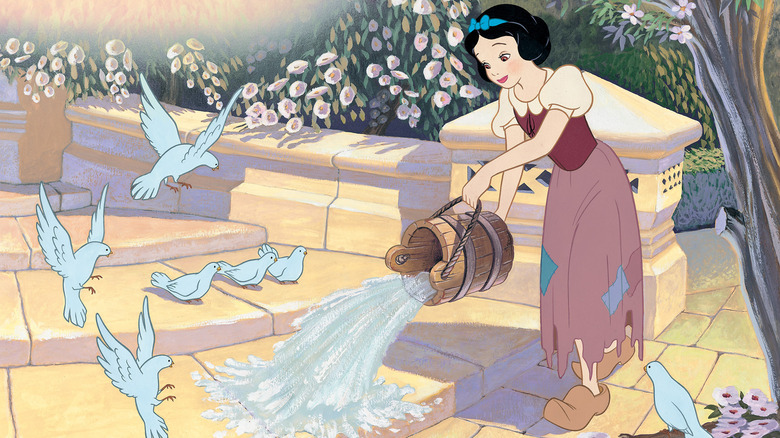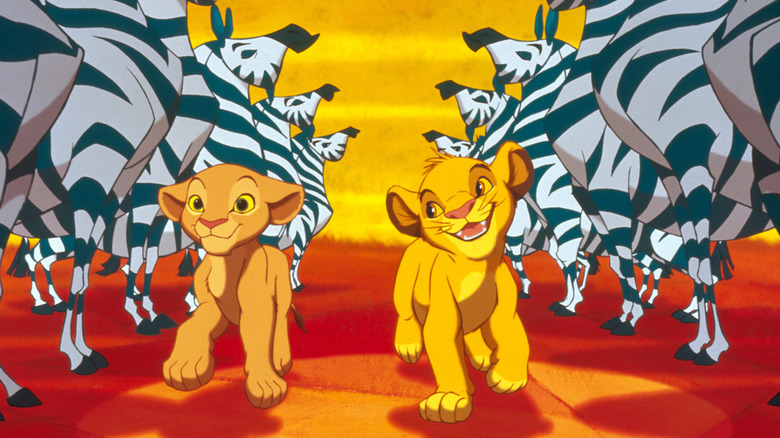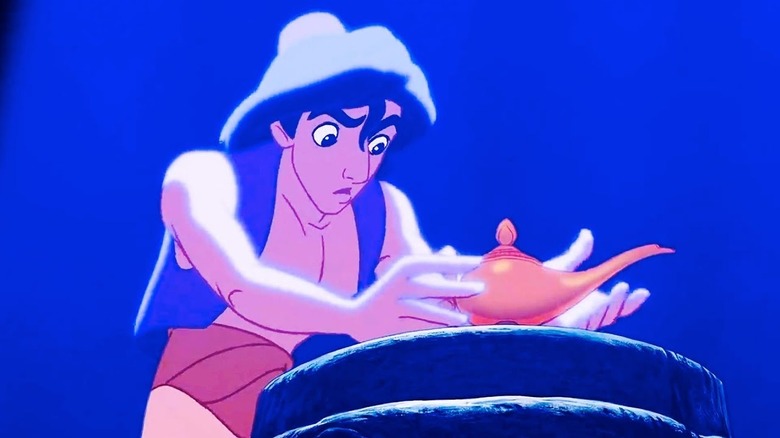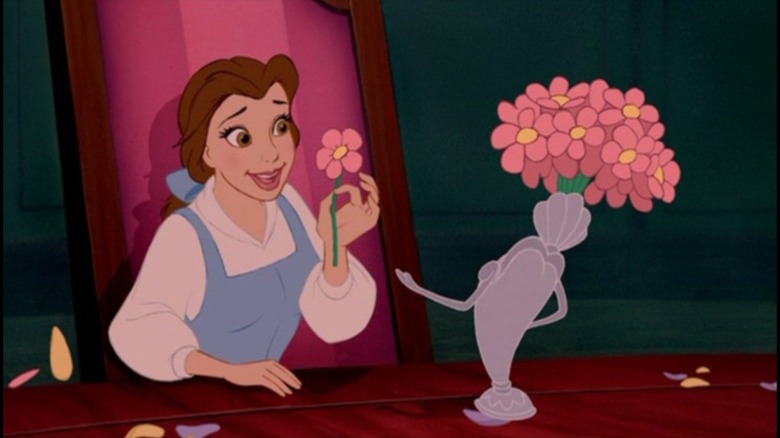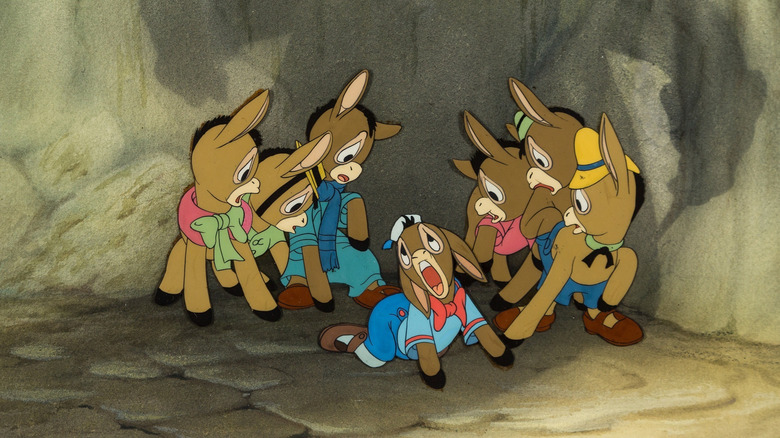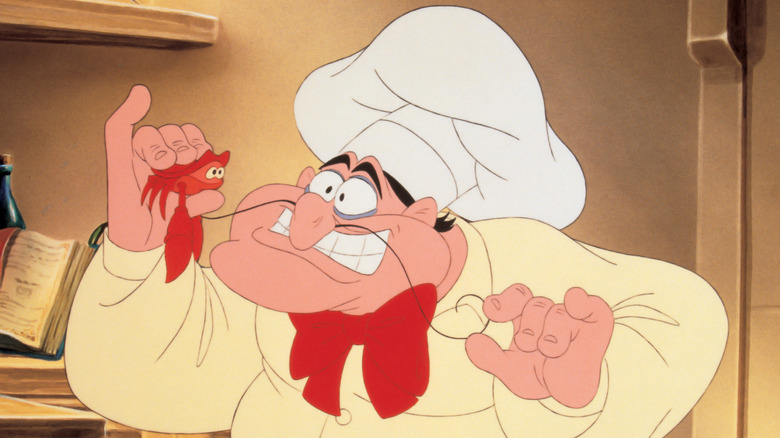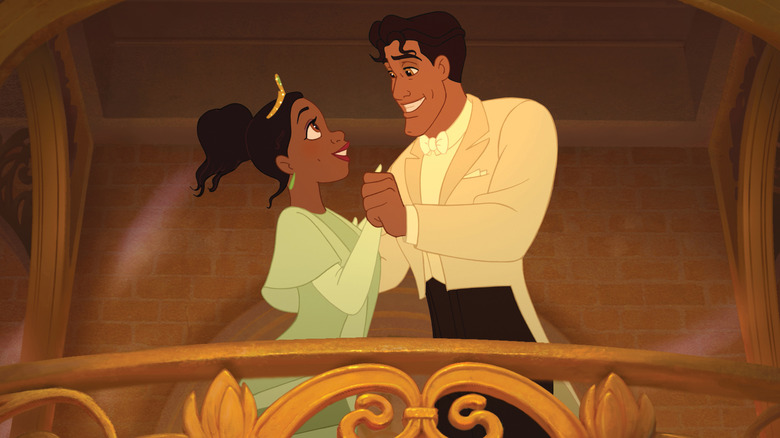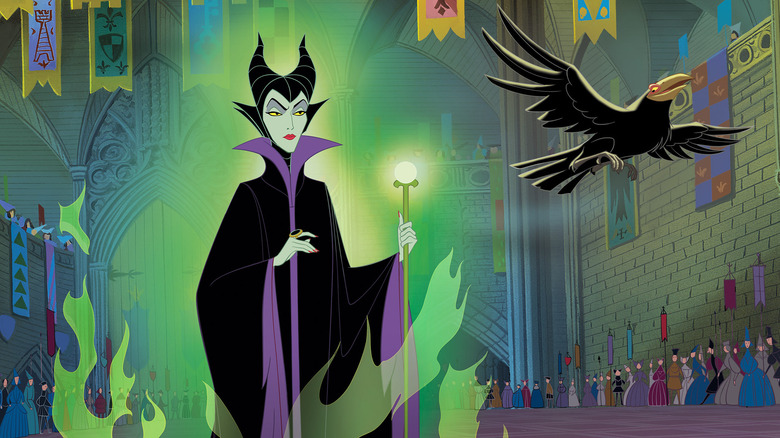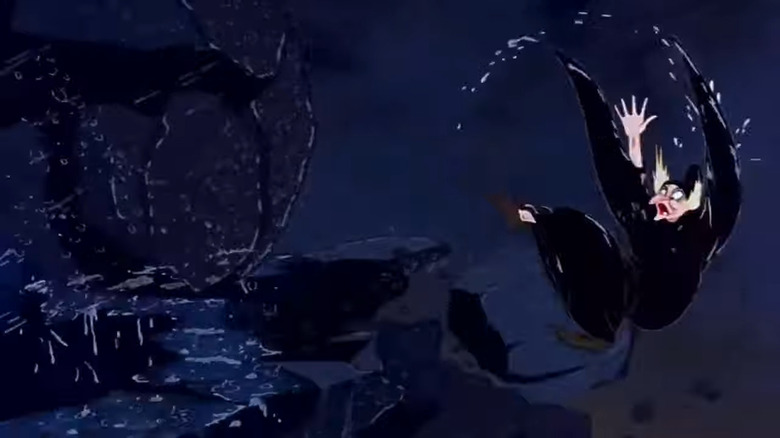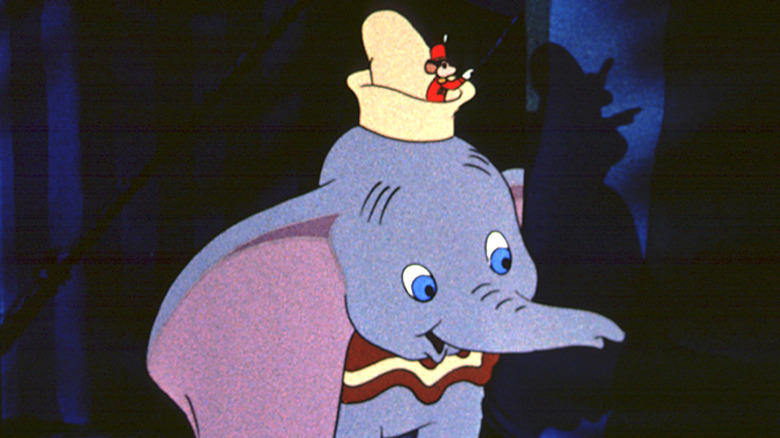Dumb Things We All Ignore In Disney Movies
The Walt Disney Company is as all-American as apple pie, baseball, and Abe Lincoln. But after decades of ruling the box office, flooding stores with stuffed animals and princess dresses, and promoting the most popular chain of theme parks in the history of the world, it's hard to ignore the fact that the House of Mouse has a tendency to release animated movies that are downright loaded with goofy things — and we're not talking about everyone's favorite giggling dog.
Whether it's ridiculous plot twists that the movie's characters never question, the sight of hundreds of dishes breaking into operatic song at the drop of a hat, the fact that almost every character is missing one or both parents, or the near-universal expectation that true love will save the day, Disney definitely clings to its favorite tropes and wrings every single laugh and tear it can out of audiences with them. Even the best Disney movies of all time have them, and we can expect it all to end with a big, splashy wedding ceremony filled with talking horses and tweeting birds, to boot.
Here's a big compendium of all of the most ridiculous tropes you can expect to see in nearly every animated Disney film — and why we're so utterly charmed by them. After all, we'd never dare to really question what we're being fed by everyone's favorite purveyor of family entertainment.
Everyone sings all the time
It's such a frequently applied and nonsensical trope that "Frozen" and "Enchanted" outright made fun of it, but you have to admit it is pretty ridiculous that in most Disney films characters tend to break out in song at the drop of a hat. You can argue that this fits in with the Broadway feeling of every single animated production the studio releases, but no one in any of the films question why this happens, or how everyone knows every word to every song put forth by each singing Disney princess.
And then the choreography kicks in, pulling even the most ham-footed characters into a big dance number. Whether it's salt and pepper shakers doing the can-can or lions and ostriches lining up to add a splash of support to Simba's cry that he "Just Can't Wait To Be King," most Disney movies contain that one special moment where every single character will begin to dance and sing as if there's something in the air.
Naturally, this isn't awful — fans of Disney films expect such fol-de-rol, and they want to leave the movie theater singing and cheering along with their favorite characters. But it is kind of dumb if you really sit and think about why these folks would suddenly trip the light fantastic to express their emotions aloud. But people who really love animated films — and musicals — are happy to overlook the silliness of it all in exchange for the wonderful memories hearing Disney and Pixar movies' songs conjure up.
Everyone's an orphan (or will be)
This happens so frequently that even Disney itself makes fun of the trope; every single fan of the House of Mouse's legacy of films knows that if they pick any Disney film at random and watch it, odds are high that one or both of the main character's parents will die or already be dead. Whether they spend their time scrapping on the streets like Aladdin, cheerfully singing while scrubbing the floor like Snow White, or coming of age among meerkats and warthogs like Simba, Disney loves its plucky orphans.
For extra conflict, many of their heroes and heroines end up with a single parent left alive. Sometimes this is done so the remaining parent can support the main character's dreams and ambitions, like Belle's dad does in "Beauty and the Beast," or to provide someone to rebel against, a role Ariel's dad, King Triton, fills in "The Little Mermaid." It's rare, but this trope can even be played for humor, like Kuzco in "The Emperor's New Groove," who is guiltily spoiled by his royal advisors and lauded with toys after being orphaned as a baby. For an extra touch of angst, some heroes — like Bambi or Simba — are forced to witness one of their parent's bloody death with their own two eyes.
But in some of these stories, the parental death is utterly unnecessary and completely dumb. A hero's journey could easily kick off without memories of their dead mom to push them into it. And some heroes and heroines — like Aurora in "Sleeping Beauty" — even get to keep both parents. Frankly, it's a little ridiculous that so many of Disney's movies kill the parents off.
Disney heroes and heroines aren't shocked by things that defy logic
Magic can warp feelings, change dresses, and put villains on ice for good; in short, it tends to cement over some of the biggest head-scratchers in the Disney universe. But even with magic involved with most Disney movie plots, there are some major logic gaps that happen every once in a while that make you wonder what on earth the characters are thinking when they're confronted by something wholeheartedly shocking. If you think too long and hard about these instances, the movies will leave you flummoxed by the main characters' reactions.
For example, in "Beauty and the Beast," in Belle's boring, ordinary hometown, she's surrounded by inanimate objects that don't have minds of their own, like her beloved books or her father's inventions. But when she reaches the Beast's castle, she hardly blinks when confronted by singing candlesticks, motherly teapots, and officious mantlepiece clocks. (Interestingly enough, the books from Beast's enormous library don't move on their own; there's not a single librarian to be found among the stacks.) In Mulan's world, animals don't talk and spirit guides don't wander much among the living, so why isn't she shocked by the sudden appearance of Mushu?
To be fair, Disney movies tend to avoid this logic question by making talking animals with human sensibilities completely logical parts of each story's universe — like Cinderella's talking mice, the anthropomorphic foxes in "Robin Hood," and Tod and Copper in "The Fox and the Hound." But in other films, like "Mulan" and "Beauty and the Beast," their existence should cause at least some level of shock.
Plot holes, for one and all
Speaking of major plot holes, it's best to not think too hard about how certain elements are introduced and then discarded in some Disney films. If you focus on them, these empty twists will leave you wondering what the heck is going on, why they were introduced only to be ignored for the rest of the movie's story, and why on earth we just spent twenty minutes in a swamp with an alligator we're never going to see again.
Consider Pleasure Island, where Pinocchio goes to goof off with a group of delinquents; a move involves drinking and smoking, it's definitely one of those animated Disney movie moments that haven't aged well. Despite partaking in these illicit behaviors, the puppet escapes his fate and avoids being permanently turned into a donkey — but the boys he's with aren't so lucky. However, Pinocchio never brings them up again, never tells Geppetto, and never spearheads their rescue; they're donkeys forever, from then on. And since Pinocchio barely learns his lesson from this encounter, it leads us to wonder what the point of this adventure really was.
While most Disney films avoid such extraneous plot developments, it's hard to ignore the fact that there are also plenty of movies with interludes that detract from our central heroes to spend time galavanting about. We wouldn't give up "I Wanna Be Like You" for anything, but King Louie definitely eats minutes from "The Jungle Book" that could have been spent with Mowgli's wolf family, who get the short shrift. But for every failed ability to balance a narrative, there's at least a great song or a breathless chase scene to fill that gap. But speaking of thinking too hard about silly plot elements ...
Don't think too hard about those singing fish
The fact that there are so many sentient animals in any Disney film can definitely leave the audience with a bad taste in their mouth — especially if the movies in question don't follow Nemo's credo of, "Fish are friends, not food" and show off the characters' less-than-vegan eating habits.
When Ariel enters Eric's palace in "The Little Mermaid," her dear friend Sebastian is nearly cooked and eaten while she awkwardly waits to have supper with her hosts. That implies that Eric's chefs have a propensity for cooking seafood, which begs the question: how many of Ariel's friends have ended up in his belly, and does his chef keep on serving them up after the couple marry? It's a dumb question — and it's also the sort of thing that the writers might have avoided with a reworked final script.
But the silliness doesn't stop there; how about those prancing zebras, birds, and other animals who more than likely end up as food for Simba's family? What about those dancing breadsticks, which Belle likely ate after "Be Our Guest" wrapped? And don't think too hard about the social hierarchy in "Zootopia." Just what are those alpha animals eating, anyway? While this might be a dumb thing that no fan of Disney ought to think too deeply about, it's still a notion that could be easily explained away with a little more self-acknowledging winking from the writers.
True love will often fall into your lap - and it won't be questioned
There's nothing Disney's animatd films like more than a good romance. Cooing, shared duets, and moonlit walks beside a lazy river – Disney's best and worst movies alike tend to have that moment where our central couple tumbles head-over-heels for one another and then quickly turns their lives into a topsy-turvy mess. But the trouble with these frequent flights of romantic fancy is that there are only so many ways two people can get together.
The vast majority of Disney couples are formed via that old-fashioned storytelling trope: the meet cute. Anita and Roger from "101 Dalmatians" get tangled up in their dog's leashes, and Prince Phillip finds Aurora singing in the woods as she's looking for romance. At their core, most Disney pairings are just two people who accidentally bump into each other. To be fair, a lot of couples do meet this way in real life, so it's not surprising that this is a frequent trope in the Disney world — but some originality would be appreciated after decades of Disney couples getting together through accidental means.
A number of couples do manage to avoid this fate; Belle and Beast meet ugly, if anything, and Cinderella encounters her prince when she's formally introduced to him during a ball. Some Disney couples experience love at first sight at a distance, like Ariel and Prince Eric. But the meet cute is applied so frequently to Disney's romantic connections that it's become ridiculously predictable.
The wicked will be killed, instead of redeemed
Another classic Disney trope puts an end to evil in ways that tend to be quite predictable. When it's time for a movie to end and wickedness must be dispatched, even the best of Disney's villain squad has to die in a manner that's bloodless but still scary enough to give little kids nightmares. Think of Gaston tumbling to his death, Dr. Facilier being literally dragged to the "other side," Captain Hook being gulped down by a crocodile, or Maleficent taking a sword to the chest while she's in dragon form.
Disney loves to fling its villains to their death from clifftops; many of its villains have passed away in this manner, which leaves plenty of room for bodies to be recovered and sequels to bloom to life. But every single hero who shrugs and accepts their happy ending without being sure they've seen a body is, well, just plain stupid — especially when they're dealing with wicked witches. Admittedly, it's a simple enough storytelling solution, even if it makes everyone look somewhat unintelligent. It's violent, but not PG-level violent, giving the villains a fate deadly enough to satisfy the audience without endangering those sweet family dollars.
Perhaps recognizing the trend, recently, the studio has been trying something different with its bad guys in more recent years. Live-action remakes have completely changed the fates of the likes of Maleficent and Cruella de Ville, and in the animation world, Yzma from "The Emperor's New Groove" survives to inhabit the body of a kitten, and Te Fiti from "Moana" turns back to the side of righteousness.
Happily ever after usually means weddings
While they've quietly been making this less of a plot point as time has gone on, for decades, almost every animated Disney movie ended with a wedding of some sort — or, at the very least, an implied engagement. Unless the movie is about children or baby animals — like "Peter Pan," "Dumbo," or "Alice in Wonderland" — happiness for the film's central couple usually involves running toward the bliss of a shared future. Even "Bambi" ends with the prince of the forest becoming its king, claiming a mate, and having children.
It's predictable and, in some cases, predictably silly. If you'd just spent years in a coma, dancing around with your true love probably feels like an enormous burden. When your dearest friends just killed your evil stepmother and now you own a chateau, who has time to plan their nuptials? But it's a Disney movie, and Disney films mean true love and happily ever after, complete with thrown rice and horse-drawn carriages, no matter how doofy it is considering the just-finished adventure that immediately preceded the big wedding celebration.
Thankfully there's been more room for creativity in more recent Disney movies. Moana becomes a wayfaring adventurer instead of a mother, for example, and Merida of "Brave" ends up mending her family back together instead of marrying. In fact, most Pixar movies eschew romance altogether to teach stories about teamwork, love, and satisfaction. A lot smarter than waiting for true love's kiss.
Disney's magic system makes its characters' deaths seem paltry
One thing that not even true love can fix is the slapdash manner with which Disney plays with magic, even inside of the logic of its own individual movies. Aside from the general predictability of Disney's villainous deaths, the way they conflict with the magic many of the villains wield is quite ludicrous. There's almost always a magical system in place that makes its villains seem so mighty, so unconquerable, that their deaths simply make no sense.
Sometimes, Disney puts thought into the ways its most magical characters meet their fates. Dr. Facillier's death was fitting and creepy, and it takes all three fairies and Phillip's might to kill Maleficent. But then you have "Snow White's" Evil Queen, who can trap a spirit in a mirror and literally shapeshift — and she just falls off a mountain after being struck by lightning. Huh? Is she not mightier than such a fate? Disney's villains often die in such weak ways that make you wonder whether they were truly that powerful in the first place.
Disney's approach to magic works best when it's treated like Tinker Bell's existence in "Peter Pan." Sometimes, "It is the way it is" works perfectly as an explanation. "Sleeping Beauty" even uses the magical limits of its central fairies to explain Aurora's enchantment and their inability to fully protect the castle and its inhabitants from Maleficent's evil.
The heroes always run away from their problems
Of course, some things can't be explained away by magic — like youthful fears and rebellion. When the going gets tough, even the toughest Disney hero gets going. Instead of taking on their problems head-on and facing down the music, they tend to run away. It's an effective narrative trick that ends up easily adding narrative drama into any motion picture — but it's also incredibly predictable.
Usually, it's an excuse for orphaned or threatened characters to grow up and start anew in the bosom of an adopted family. Whether it's Simba running from his father's death to be raised by Timon and Pumbaa, Snow White finding succor with the seven dwarves, or Aurora getting carried away from her home castle to be taken care of by her fairy godmothers, Disney protagonists just seem hardwired to turn tail and run before they learn to stand up and fight.
The problem is, it's happened more times than we can count in Disney movies. While it definitely works as a boon to the movie's supporting cast and lets most Disney protagonists grow to maturity with a simple montage, it might be interesting to see some characters face the music instead of taking wing. But in the end, without these common — if occasionally dumb — Disney tropes, we wouldn't have so many lovable movies to behold.
